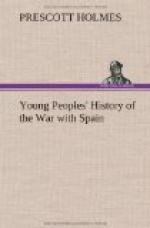You must understand that the city that our troops wanted to reach was Santiago, but between them and it lay this rough country, where marching would be so hard, and where the Spaniards had forts on some of the hilltops.
[Illustration: Landing Troops at Daiquiri.]
CHAPTER VIII.
The battle of Las Guasimas.
A Number of our officers thought it would be best not to go forward till some roads had been made, so that the army wagons could be sent on; but General Shafter thought it would be best to march on at once. He feared that after a week or ten days in that climate many of our men might have fever and be unfit for service. So, even before all the men had landed, General Shafter ordered the first ones to go forward and drive the Spaniards from a place near Siboney. Thus, some of our troops began their march just after landing from the boats. About two hundred Cuban soldiers went with them, to lead the way and watch for the hiding places of the Spaniards.
The troops reached the place in the evening, but found that the Spaniards had left it and gone about three miles further westward to a stronger fort. Our men rested all night, and before daylight the next morning—Friday, June 24th—they marched on to hunt the enemy.
Now I must tell you something about these soldiers who were going to fight their first battle in Cuba. There were nearly a thousand men; some were “Regulars,” others were “Volunteers.” They belonged to the Cavalry division of the Army—the soldiers who go on horses. But for this first work in Cuba they had to go on foot, without their horses.
The “Volunteers” numbered about five hundred. They belonged to a regiment called the “Rough Riders,” and a strange regiment it was. Most of these men were from the prairies and cattle-ranches in the West; some were “cowboys,” some were Indians. The others in the regiment were young men from the East—business men, college men, sons of rich men; all were brave, hardy fellows, fond of out-door life, fond of excitement, not afraid of work. These young men had been trained for the war by a man who was now one of their officers, Lieutenant Colonel Roosevelt. He had given up a high position in order to serve his country in this way. People in the United States laughed when this company of “Rough Riders” was formed, and said that the “cowboys” and Indians would not obey orders, and that the others would not stand the hardships of war. But the people in the United States did not laugh after the battle of Las Guasimas.




